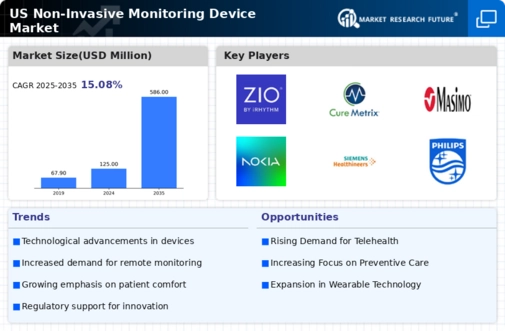Rising Prevalence of Chronic Diseases
The increasing incidence of chronic diseases such as diabetes, hypertension, and cardiovascular conditions is a primary driver for the non invasive-monitoring-device market. In the US, approximately 60% of adults have at least one chronic condition, which necessitates continuous monitoring. This trend is pushing healthcare providers to adopt non invasive solutions that allow for real-time health tracking without the discomfort associated with traditional methods. The demand for devices that can monitor vital signs, glucose levels, and other health metrics is expected to grow, as patients seek more convenient and less intrusive options. Consequently, the non invasive-monitoring-device market is likely to expand significantly, with projections indicating a potential market value exceeding $10 billion by 2027.
Consumer Awareness and Health Literacy
Consumer awareness regarding health and wellness is on the rise, which is positively impacting the non invasive-monitoring-device market. As individuals become more informed about their health, they are increasingly seeking tools that enable them to monitor their conditions effectively. This heightened health literacy is driving demand for non invasive devices that provide accurate and accessible health data. Manufacturers are responding by creating devices that are not only effective but also user-friendly, appealing to a broader audience. The market is likely to benefit from this trend, with projections indicating a steady increase in sales as consumers prioritize their health and seek innovative solutions to monitor it.
Technological Integration in Healthcare
The integration of advanced technologies such as artificial intelligence (AI), machine learning, and the Internet of Things (IoT) into healthcare is transforming the non invasive-monitoring-device market. These technologies enhance the functionality and accuracy of monitoring devices, enabling better data collection and analysis. For instance, AI algorithms can analyze patient data to predict health issues before they become critical, thereby improving patient outcomes. The market is witnessing a surge in the development of smart wearables that not only monitor health metrics but also provide actionable insights. This technological evolution is expected to drive the non invasive-monitoring-device market, with a projected growth rate of around 15% annually over the next five years.
Increased Focus on Preventive Healthcare
There is a growing emphasis on preventive healthcare in the US, which is significantly influencing the non invasive-monitoring-device market. As healthcare costs continue to rise, both consumers and providers are recognizing the importance of early detection and management of health issues. Non invasive monitoring devices facilitate proactive health management by allowing individuals to track their health metrics regularly. This shift towards preventive care is likely to increase the adoption of these devices, as they empower users to take charge of their health. The market is expected to see a compound annual growth rate (CAGR) of approximately 12% as more consumers seek out non-invasive solutions to maintain their health.
Aging Population and Demand for Home Healthcare
The aging population in the US is a significant driver for the non-invasive monitoring device market. As the baby boomer generation ages, there is an increasing demand for home healthcare solutions that allow elderly individuals to monitor their health from the comfort of their homes. Non invasive devices are particularly appealing to this demographic, as they offer ease of use and comfort. The market is responding to this demand by developing user-friendly devices that cater to the needs of older adults. It is estimated that by 2030, nearly 20% of the US population will be over 65, further propelling the growth of the non invasive-monitoring-device market as more seniors seek to manage their health independently.

















Leave a Comment